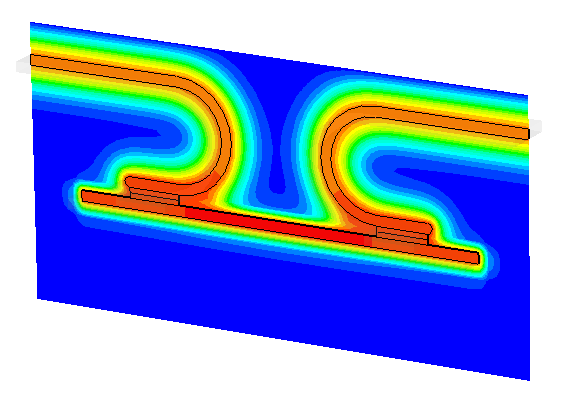


This examples demonstrates the combined analysis of a circuit breaker with the stationary current solver and the transient thermal solver. It is assumed that a high current can passes the circuit breaker for 120 ms before the circuit is disconnected. During this period the high currents will heat up the device significantly, which can be simulated with the thermal transient solver.
The contact springs will be constructed using the line and arc curve tools. The resulting curve can then be traced to form a solid. On either side of the contact area a gold pad is associated that can be constructed with the extrusion tool. For the construction of the bridge, a local coordinate system is employed to make creation of the brick easier. The whole structure is embedded into a porcelain body which is used for electric insulation but also allows to heat from the device.
The copper springs and the golden contact pads consist of highly conducting material. Two current ports are attached to the springs with potential value 0.05V and -0.05V. All boundary conditions are set to type tangential in order to prevent the current ports from being short-circuited. A tetrahedral mesh is used to discretize the model. The solver accuracy is set to 1e-6 for the stationary current solver to calculate the current flow and the electric field in the conductor.
The thermal simulation is driven by the loss distribution from the stationary current solver. The excitation pulse lasts 120 ms and increases the temperature to a maximum of 317 Kelvin. Two 3D time domain temperature monitors have been defined to record the whole process with a low sampling rate and the heating process with a fine sampling.
After the solver runs have been computed one can observe the stationary current- and the thermals-results. Under "1D Results\ThermalTD\Energy" one can observe how the total thermal energy rises during the heating process and slowly decreases after the current flow has been interrupted.